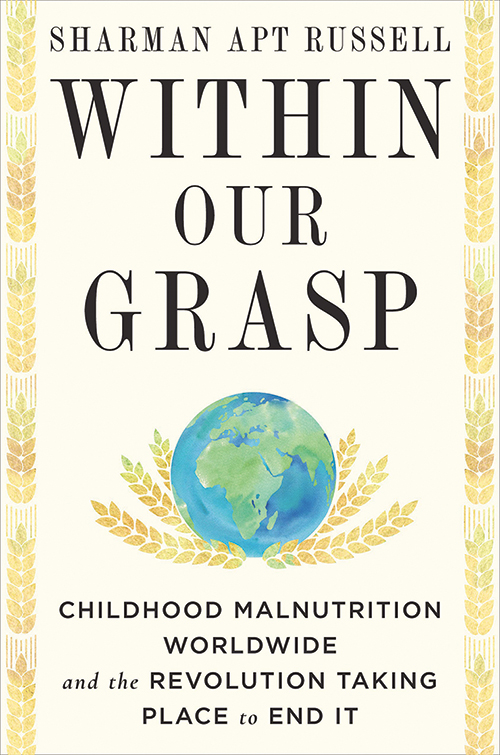
Within Our Grasp: Childhood Malnutrition Worldwide and the Revolution Taking Place to End It
Reviewed by Margaret Crompton
August 1, 2022
By Sharman Apt Russell. Pantheon, 2021. 336 pages. $28.95/hardcover; $13.99/eBook.
“The power of a story can change the world.” The final paragraph of this book tells me how to read it: as a compendium of stories illustrating the theme that “[f]eeding all our children is about who we are and who we want to be.”
At first, I found this beautiful volume confusing: the fine quality paper and binding, elegant design, generous photographs, index, notes—how could such luxury communicate about poverty, malnutrition, stunting, and death? Then I remembered how I as a social worker had demonstrated respect for my clients by dressing neatly, being punctual, and fulfilling promises. The material beauty of this book in itself respects the people about whom—and on behalf of— Sharman Apt Russell writes.
Before I met those people, I had another question. For whom is the book intended? The first word of the prologue (which is “I”) indicates autobiography and personal testimony. The author is an experienced writer of fiction and nonfiction, and a university professor. The prologue conveys her concern that nearly one in four of the world’s children is stunted: deprived of nourishment essential for healthy growth and development. The core theme of the book is exploration of initiatives to end childhood malnutrition. Its content consists of research in Malawi conducted by the author and her husband, as well as contextual background history and information about programs worldwide.
Although at first I felt like an interloper, my role as reviewer encouraged me to read with extra care. I was soon accompanying the author on her journeys and sharing her encounters. She is welcomed into clinics and kitchens, laboratories and latrines. She reviews the development of RUTF (ready-to-use therapeutic food): cheap, plant-based compounds of essential nutrients, and she visits communities working with initiatives to make best use of local land and climate conditions.
Stories of disappointment and endeavor, disaster and achievement, and deliverance and death reached me through her eyes and words. I was shocked by statistics, engaged by information, and moved by life. The clear, direct writing quickly assured me that this was not a specialized text. The discipline of reading as a reviewer led me to people and places I would not otherwise have encountered. I recommend this book.
Chapter 17 discusses comparative finance. One statistic stays with me: $95 billion was spent in 2019 in the United States on pets and pet products while $50 billion was needed over ten years to reduce stunting worldwide by 40 percent. These are huge figures that are beyond my imagination, yet miniscule amounts per child, per life.
As I read one chapter a day through March, war returned to Europe; healthy children were being killed. Wealth was squandered on bullets and bombs: resources that could have saved innumerable lives through the achievable expedients described in this book, resources almost within our grasp were wasted.
The message I take from the book is that small initiatives can give life. Along with Sharman Apt Russell, I believe “Healthy children require a healthy Earth.” Like her, I have faith that “the power of a story can change the world.” But I ask: how many more stories are needed to power that change? And who listens?
Margaret Crompton (Britain Yearly Meeting) has developed ideas and practice in communicating with children in the context of social work/care. Her numerous publications include Pendle Hill pamphlet 419 Nurturing Children’s Spiritual Well-Being (2012).


